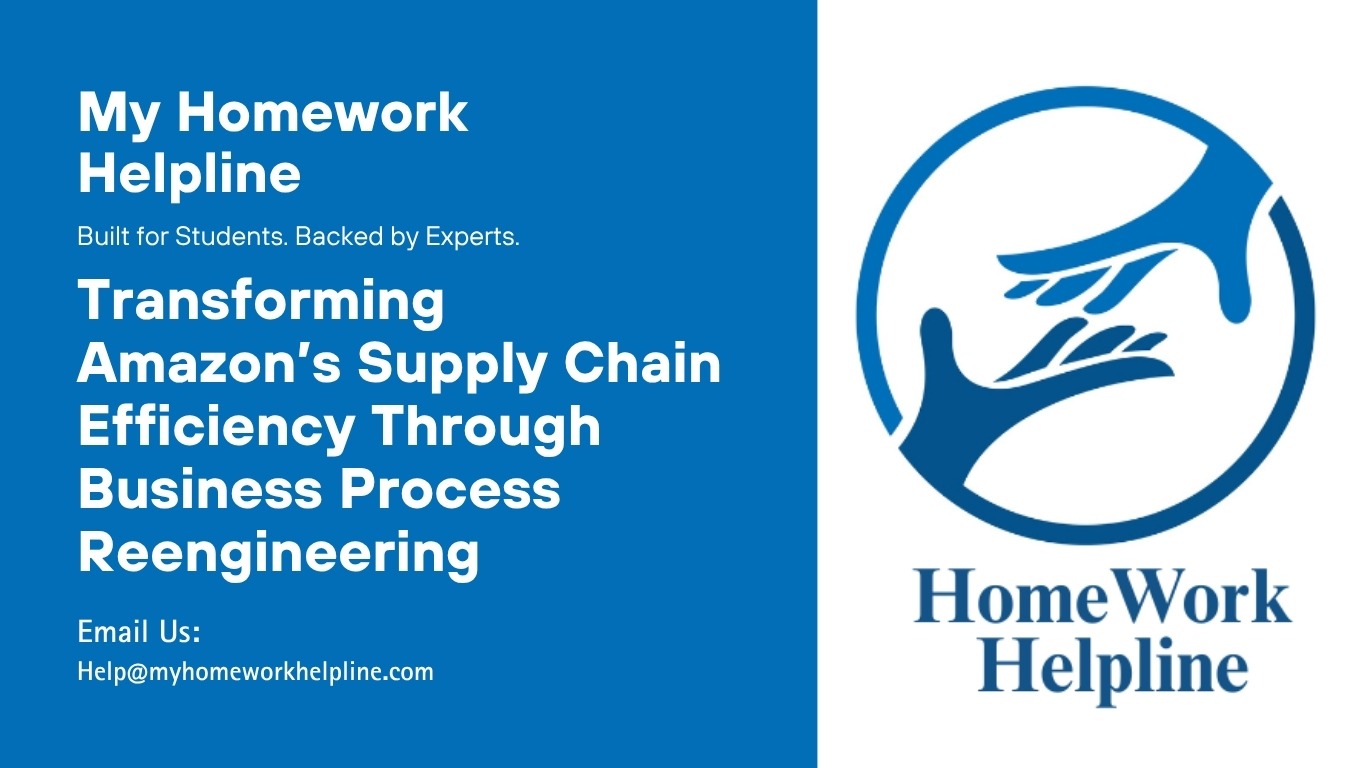How Business Process Reengineering Can Transform Amazon’s Supply Chain Efficiency and Customer Satisfaction
Processes can be undermined and considered minor in a business, but they play a crucial role in the growth and development of a company. Businesses that have undertaken the initiative to implement various processes have been able to meet their market target and goals, which has helped their growth. Amazon is one of the largest online platforms in the world, and many customers take the initiative to make purchases from them. Still, at times, some inconveniences reduce customer satisfaction. To complete the assignment, I have selected Amazon Company, an online-based business that deals with all types of products, as the targeted business to apply Business Process Reengineering (BPR). The company needs help in the chain management process, leading to delays in product delivery and increased costs. The issues can be addressed effectively by applying the five-step process mentioned in the Sinha article.
Step 1: Identifying processes for redesign
This is the first step to help apply BPR in the Amazon organization. Amazon has an outstanding chain management that needs critical improvement. Chain management involves procurement, inventory, and distribution (Sinha et al., 2020). If the management can analyze the current workflow and identify the inefficiencies, a foundation can be laid for process design. Research must be conducted to develop a formulated identified process that will help understand and implement a method in the company.
Need expert assistance with Business Process Reengineering or supply chain management assignments? Visit our Business Studies Homework Helpline for professional support and ensure top grades!
Step 2: Understand and analyze the existing process
After identifying the target process, the next step the company should take is to understand and analyze the existing process thoroughly. This involves analyzing current workflow, identifying key stakeholders and gathering data performance metrics such as inventory turnover and on-time delivery rates. With the help of interviews and surveys, we can gain insights into the root causes of inefficiencies and areas of improvement in the supply chain management process. Employees can also provide helpful information to help understand the problem that the company is experiencing and how to come up with a solution.
Step 3: Redesign the process
Based on the analysis in step 2, the next step that the company should take is to redesign the supply chain process. Some steps it should take are streamlining workflows and introducing automation technologies to improve efficiency and reduce cost. Technology is crucial in business development and reducing risks (Nkurunziza et al., 2019). For example, implementing a technological inventory management system with accurate time tracking helps optimize inventory levels and reduces stock-outs. Inventories are crucial to a business, and not having proper data might lead to a crisis. Maintaining clean inventory sheets that might be used for future reference when needed is essential. Also, having a strategic partnership with key suppliers and implementing just-in-time inventory can enhance the efficiency of the procurement process.
Step 4: Implement the redesigned process
Once Amazon has developed a redesigned process, it is essential to implement it effectively within the organization. To implement the process effectively, there is a need to have proper communication, training and change in management initiatives to ensure a smooth transition to the new workflow. Also, it is crucial to monitor the implementation of the process closely, get her employee feedback, and address any issues or concerns that may arise during the implementation process. Employees play a crucial role during this time, and listening to their ideas and adjusting according to some of their views is essential.
Step 5: monitor and continuously improve
Monitoring and continuously improving the implemented process is the final step in BPR, and it involves monitoring the performance of the redesigned processes and constantly seeking opportunities for improvement (McMaster et al., 2020). It tracks key performance indicators (KPIs) related to the supply chain process, such as customer satisfaction. By conducting regular reviews from the stakeholders, we can identify areas for further optimization for ongoing improvement and innovation. This step is crucial since you can identify the shortcomings that came along with the new process and how to work on those shortcomings. It requires a lot of professionalism to ensure the implementation continues but instead makes continuous progress for the company.
Concluding Remarks
In conclusion, applying the business process reengineering(BPR) concept to Amazon can significantly improve efficiency and customer satisfaction in supply chain management. The main aim of a business is to meet its customer’s needs, which will help improve sales and, hence, increase profits. This will help in the gradual growth of the company. Following the five steps outlined in Sinha’s article, we can systematically identify, analyze, redesign, implement, and continuously improve the targeted process to achieve desired outcomes and goals. Also, it is important for companies implementing BPR to be aware that the process is not a one-time initiative but an ongoing journey of adaptation and optimization to meet evolving business needs and market competition.
References
McMaster, M., Nettleton, C., Tom, C., Xu, B., Cao, C., & Qiao, P. (2020). Risk management: Rethinking fashion supply chain management for multinational corporations in light of the COVID-19 outbreak. Journal of Risk and Financial Management, 13(8), 173.
Nkurunziza, G., Munene, J., Ntayi, J., & Kaberuka, W. (2019). Business process reengineering in developing economies: Lessons from Uganda’s microfinance institutions (MFIs). Innovation & Management Review, 16(2), 118-142.
Sinha, A. A., Rajendran, S., Nazareth, R. P., Lee, W., & Ullah, S. (2020). Improving the service quality of telecommunication companies using online customer and employee review analysis. Quality Management Journal, 27(4), 182-199.

